Neurobiology of Trauma
and Treatment |
James
Kowal, M.S., LCPC |
| 4. ORGANIZATION OF
MEMORY |
|
|
|
|
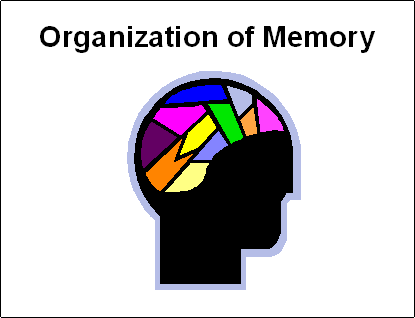
|
|
From the
theory presented to this point, we will now formulate a model of the way traumatic
memories are processed and stored. If you could represent a memory trace as a line stored
in a specific location by the hippocampus, memory tracks might look something like this:
There are of course some shortcomings to
this simplification: |
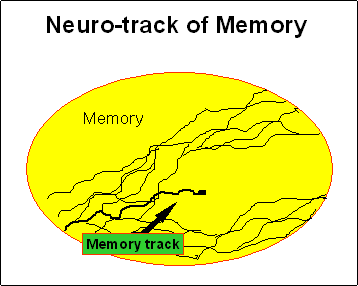
|
|
|
|
First, memory is not stored in
two-dimensional space. The cortex of the brain is a complex array of interlinking neurons
in three-dimensional space.
Second, the illustration
indicates that memory is only a single channel, when in fact memory is better represented
as a "braid" of at least four channels. The next slide describes this braid
according to the BASK model (Braun, 1988). |
|
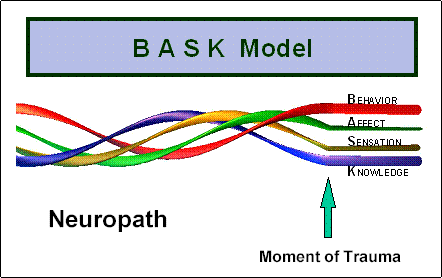 |
Memory
traces record information on at least four channels: behavior, affect, sensation, and
knowledge (BASK).
These information channels seem to be tightly linked in some sort of
structure, and the "braid" is a vivid physical metaphor for envisioning how the
information channels are related. |
|
|
Consider a life event that
is being recorded, as represented by the heavy black line beginning on the left of the
diagram below. It is storing information contiguously as the line moves to the right. Then
something radically changes. If the person is suddenly and painfully grabbed, or if there
is an ominous crashing sound, or if someone jumps out from behind a bush and knocks the
person to the ground, the system receives the information, routes it through the
pre-frontal cortex, and around to the amygdala, which suddenly computes a significant
difference and immediately notifies the hippocampus. |
|
The
hippocampus recognizes that the affect has suddenly and radically changed and in effect
says, "Store the incoming data way off over there" (indicated by the red
segment, broken off and stored in an area where there are little or no other memory
traces). The phenomenon creates a discontinuity, or what I call a "hurt spot." |
 |
|
|
Notice that the broken-off
segment is located in an area where there are few or no other memories. This illustrates a
case of single-incident trauma. Much more occurs when there has been severe or repeated
abuse in children, especially before the age in which the personality has fully coalesced.
But for now, let’s consider a single-incident trauma.
The thalamus sends pulses of energy (brain waves) at various
frequencies along the neuropaths. When a fragmented neuropath (dark pathway shown on the
slide) is encountered, the brain has difficulty pulsing energy through it and anxiety is
activated as the "hurt spot" is approached. The nervous system immediately
responds, in essence saying, "You can’t go there," and it directs the flow
of energy down alternate paths. These alternate pathways become the basis of a
"defense mechanism." Energy and attention is diverted, and unrelated thoughts or
impulses emerge, such as remembering something one has to do, wanting something to eat, or
going out for a smoke. The thalamus can be persistent and continue to send pulses down the
fragmented memory path, but since anxiety is induced by approaching the "hurt
spot," the energy is continuously directed down the alternate pathways, reinforcing
the alternate "defensive" thinking and corresponding behavior. |
|
 |
In some cases the thalamus persists in sending energy directly down
towards the hurt spot, and the
energy keeps being diverted away, again and again, in a rapid succession of send, divert,
send, divert. During these times, the body may respond with an increase in the heart rate,
a shortness of breath, shakiness, or other symptoms characteristic of a panic attack. The
thalamus, pulsing energy down the pathway, and the nervous system, diverting the energy to
alternate pathways, over and over, create (to use a cybernetics metaphor) a "tight
loop" that results in feelings of panic. |
| |
|
|
Relating
this model to the energy model of Roger Callahan’s Thought Field Therapy, anytime
energy flows along a pathway, there is a magnetic field that is established about the
pathway. Three "thought fields" are illustrated in the slide. The two
undisturbed pathways (the green and blue lines within the yellow area) correspond to the
green and blue thought fields that surround the yellow area. But the thought field that
corresponds with the pathway that leads to the hurt spot (black line) has what Callahan
calls a "perturbation" in the thought field. |
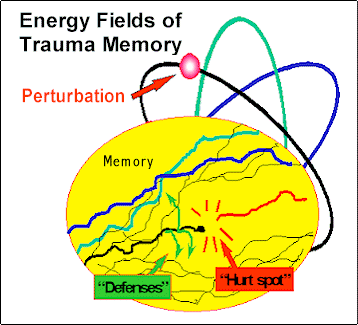 |
|
|
Perturbations are
associated with negative feelings and are the target of thought field therapy. The origin
of a perturbation is twofold. Callahan (1996) describes perturbations as primarily
originating from trauma. But he and others also speculate about the effects of energies or
"fields" in the family, culture, or environment (e.g., Sheldrake, 1995) that
influence the individual’s thought field. Whatever its source, a perturbation acts
like a block in the energy field, as illustrated by the discontinuity of the neuropath
shown in the slide. |
|
|
|
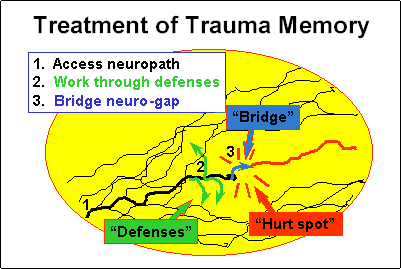
|
The
objective in trauma therapy is to recall the trauma and connect it with any broken memory
fragments. These memory fragments are often experienced as dissociative amnesia. The
"amnestic barrier" is actually not a block or barrier but rather a
break in the
continuous memory path due to the sudden perceived change in affect originating from the amygdala, as described earlier. |
|
Another
interesting property of traumatic memory is that when a memory is fragmented due to
trauma, the traumatic fragment is broken off and remains as highly charged with affect as
it was at the time it was stored. This is what some therapists call "the frozen
moment in time."
The therapist works to develop a baseline of trust so that painful material can be
processed without diverting energy away from the hurt spot. Once the client recalls the
events that caused the discontinuity or hurt spot, the memory pathway can often reconnect
with the fragmented segment (shown as the "bridge" in the slide). When this
occurs, the client remembers, usually with great vividness, the traumatic event, and most
often experiences a flood of feelings. This segment is highly charged with affect and was
broken off from normal memory, so the stored feeling had not been experienced since the
event originally occurred.
This highly charged segment of traumatic
memory works something like a capacitor. A capacitor is an electronic component that
absorbs electricity while the device is plugged in. When the device is unplugged, it
remains highly charged. If a person touches it and is grounded, the person will experience
an instant shock. However, if the capacitor has discharged (and is still not plugged in),
you can touch it again and again without any effect. A similar process occurs with the
fragmented memory segment. Once it has been remembered and the affect experienced, the
client can recall it again and again, but it no longer evokes the traumatic affect. The
client will never forget what happened, but the terrible feelings will no longer be
triggered. |
|
|
|
|
|
 |
 |
|
 |
 |
|
|
|